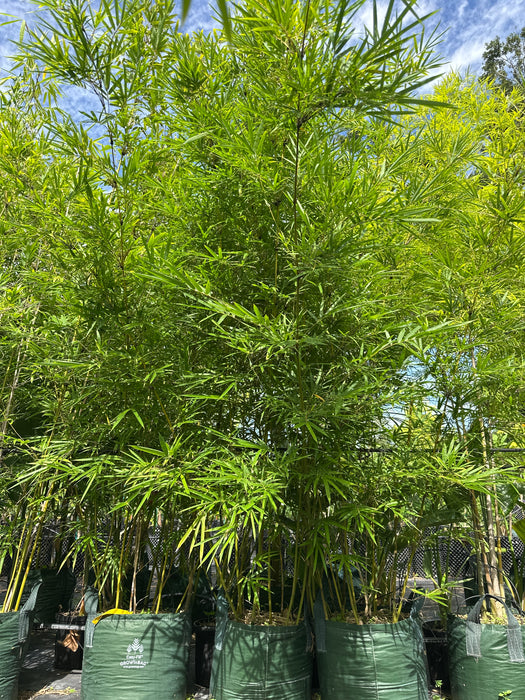
Weavers Bamboo Dwarf RG Dwarf Bamboo
Weaver's Bamboo Dwarf (Bambusa textilis 'Dwarf') is a popular bamboo species prized for its attractive, slender canes and dense foliage. Although not as tall as its parent species, Bambusa textilis, this dwarf variant offers a dense growth habit making it suitable for screens and hedges. Below is a comprehensive guide for its cultivation:
Best Growing Environment
Weaver's Bamboo Dwarf thrives in well-draining soil. A loamy or sandy loam soil is ideal, ensuring that the roots are not waterlogged. Soil should be slightly acidic to neutral in pH.
Average Height
Unlike the full-size Weaver's Bamboo which can grow quite tall, the dwarf variety typically ranges between 10-15 feet in height, though this can slightly vary based on growing conditions.
Growth Rate
Bambusa textilis 'Dwarf' has a moderate to fast growth rate. It can quickly fill in a space, especially during its peak growing season.
Sun Requirements
This bamboo enjoys full sun to partial shade. However, in areas with intense afternoon sun or very hot climates, it might benefit from some light shading during the hottest parts of the day.
Cold Hardiness
Weaver's Bamboo Dwarf is relatively cold hardy and can typically handle temperatures down to about 20°F (-6°C). Still, it's a good idea to mulch the base in the winter in areas where temperatures often approach this low to protect the rhizomes.
Water Requirements
Initially, while the bamboo is getting established, consistent watering is crucial. Once established, the plant is moderately drought tolerant but will thrive best with regular watering, especially in dry periods. Over-watering or allowing the bamboo to sit in stagnant water should be avoided.
Detailed Fertilizing Guide:
- Spring: A balanced, slow-release fertilizer such as a 14-14-14 can kickstart growth.
- Mid-Summer: Depending on the growth and the greenness of the leaves, a higher nitrogen blend like 21-5-6 can be applied.
- Autumn: Reduce the fertilizer application; a light balanced feed can suffice.
- Winter: Usually, no fertilization is needed. Always ensure that the bamboo is watered after fertilizing to prevent the risk of root burn.
Planting Guide:
- Preparation: Choose a spot with good drainage.
- Planting Hole: Dig a hole that's twice the width of the root ball but just as deep.
- Positioning: Place the bamboo such that the top of the root ball is even with the ground level.
- Backfill: Fill the hole back with soil, gently patting down to remove air pockets. Water generously after planting.
USDA Zone:
Weaver's Bamboo Dwarf is suitable for USDA zones 8b through 11. While it's cold hardy to some extent, it thrives in warmer climates.
In conclusion, Bambusa textilis 'Dwarf' is an excellent choice for those who want the beauty and utility of bamboo without the towering heights of other species. Regular maintenance and care, as outlined above, will ensure a dense, healthy growth, providing beauty and privacy to any garden.

